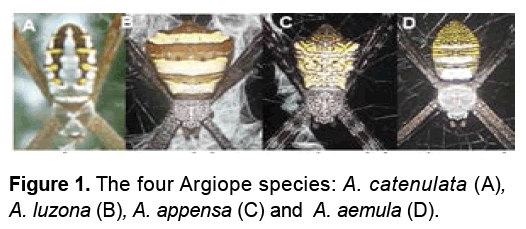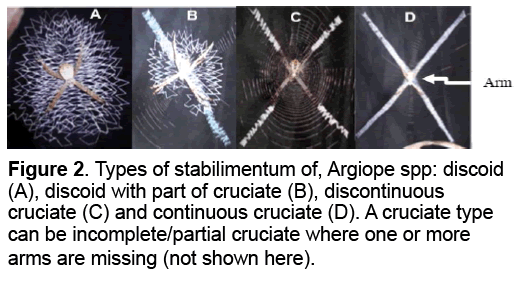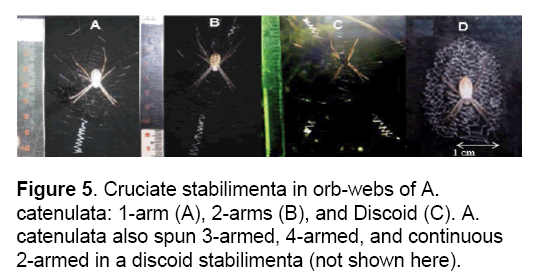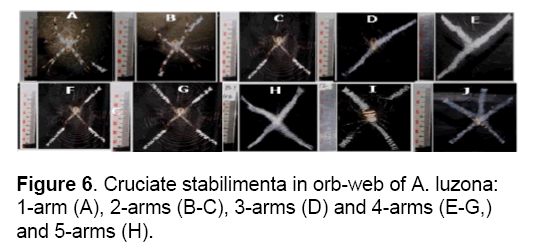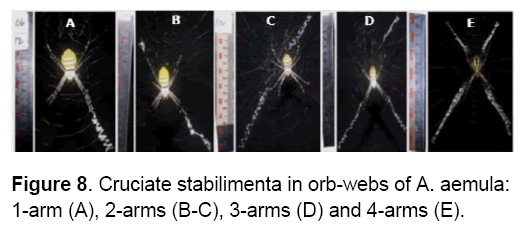Intraspecific and Interspecific Variation of Stabilimenta in Orb Webs of Argiope Spiders (Araneae: Araneidae)
Liza R Abrenica-Adamat
Liza R Abrenica-Adamat*
Assistant professor IV,Department of Biological Sciences,Mindanao State University-Iligan Institute of Technology,Tibanga Iligan City,Philippines.
- Corresponding Author:
- Liza R Abrenica-Adamat
Tel: 063 09173123302
Fax: 063 221 4068
E-mail: lizadamat@gmail.com
Abstract
Argiope spiders decorate their orb-webs with very conspicuous while zigzag silk construct called stabilimenta. This study was conducted to describe and compare the stabilimentum structure within and among the five Argiope species -Argiope luzona, A. catenulata, A. Appensa and A. Aemula. Results showed that stabilimenta is an optional component of the orb-web across the four Argiope species. The frequency, type (cruciate or discoid) form (thickness, extend: continuous or discontinuous, number of bands or arms) vary from web to web of a single individual (intra-individual variation), same species (intraspecific variation), or webs of different species (interspecific variation) which might be correlated with variety of environmental factors such as presence of prey, predators, conspecifics and other abiotic factors. The stabilimentum types of Argiope spp. were either discoid or cruciate which vary with spider size or ontogenetic stage. Small juveniles (body length :< 0.4 cm) decorate their webs with discoid type while large adult/sub adult ones (body length: >0.6 cm) spun strictly cruciate form which vary in the number of arms (1-arm to 5-arm).
Keywords
Argiope luzona; A. Appensa; A. Catenulata; A. aemula; Stabilimentum structure.
Introduction
Some diurnal orb-web spiders (Araneae: Araneidae,Tetragnathidae,Uloboridae) also spin highly visible decorations called stabilimenta at the hub of their webs. These structures vary in form and composition [1]. While some are made up of silk,others are made of combination of silk and other items such as egg sacks,vegetation and detritus,decaying prey items and exoskeletons of arthropod prey [2]. Among these types,the silk stabilimenta have many forms and have been the centre of debate in spider literature for over a century [3]). In general,silk stabilimenta are characterized by their shape (discoid,spiral,cruciate,linear),location with the web (center or in the periphery of the web),and number of arms.
Argiope spiders (Araneae: Araneidae) are diurnal stationary species that decorate their webs with very conspicuous white zigzag silk stabilimenta. In the Philippines,Argiope spiders are locally known as “Mr. X” or ’’Spider X” since these spiders rest at their webs with legs extending in “X” position. When you look at the structure of stabilimenta,its occurrence and spefic form (type and number of arms) a spider may construct were likely to vary with spider size,across the spider’s life history,spider species,and response to abiotic and biotic factors of its immediate surroundings [1]. Several hypotheses were proposed to describe the function of stabilimenta. Some researchers thought that these constructs may serve as warning design against birds that might fly through the web [4,5],may be used to startle predators by changing its size and body shape/outline [6],and may be used for hiding their body [1,3,7]. However,some of these functions were not explicitly tested. To date,two of the most accepted theories of the adaptive function of these constructs are predator avoidance and prey attraction. Both hypotheses rely on the fact that silk stabilimenta reflect ultraviolet (UV) light,and insects are attracted to UV range since it mimics an open sky/open vegetation serving as escape route or food source [8-10]. This field study aims primarily to describe and compare the stabilimentum structure in orb-webs within and among the four Argiope species -Argiope luzona,A. catenulata,and A. Aemula,and investigate some of the proposed functions of stabilimenta.
Methods
Study species and study sites
Field survey on the occurrence and form of stabilimentum in orb-webs of the four Argiope spiders- Argiope luzona,A. catenulata, and A. aemula (Figure 1) was conducted from October 28,2008 to June 20,2015 in selected areas of Mindanao,Philippines. The spider size was measured based on the total body length [11]. Unidentified small juvenile spiders collected in the field were reared in the laboratory for taxonomic identification. For comparison purposes,spiders with body in size <0.60 cm were considered juveniles while spiders in size of > 0.60 cm were considered adults.
Web parameters
A total of 3,087 webs were observed- A. luzona (N=824,26.7%),A. catenulata (N=949,30.7%),A. appensa (N=753,24.4%),A. aemula (N=547,17.7%). 2,234 (72.4%) webs were occupied with adults and 853 (27.6%) were occupied with juveniles. The stabilimentum was described based on type (Figure 2 ),number of arms and extend of arms (continuous,discontinuous). For comparison purposes,arms that crossed each other at the hub (without a gap at hub) are called continuous arms while those that leave a gap are called discontinuous arms (Figure 2 ).
Statistical analyses
Linear Correlation analysis was used to determine relationship between spider size and stabilimentum structure based on type and number of arms. In terms of stabilimentum type,ranking was employed: discoid=1 and cruciate=2. For the presence and absence of stabilimentum (silk decoration): undecorated=1 and decorated=2. Descriptive analysis was also used to describe the stabilimentum structure of Argiope spp.
Results and Discussion
The results showed that not all webs were decorated suggesting that stabilimenta are optional component of the web (Figure 3 ). The web decorating frequency range from 46.6% to 93.5% among adults and 62.2% to 90.1% among juveniles. The stabilimentum frequency varies among the four Argiope species. Among adults,low stabilimentum frequency was observed in webs of A. catenulata (46.6%) and A. appensa (53.2%). A high frequency of occurrence was observed among A. luzona (adults: 93.5%; juveniles: 81.6%) and A. aemula (adults: 89.2%; juveniles: 90.1%). A. catenulata and A. appensa juveniles spun decorated webs more frequently than the adults,with stabilimentum frequency of 82.7% and 62.2% respectively.
Figure 4 shows the relationship between spider size and occurrence of stabilimentum among the four Argiope spiders. Argiope spp. spun only two types of stabilimentum: cruciate and discoid type which varied with spider size (developmental stage),suggesting an ontogenetic polymorphism on stabilimentum structure. Very small spiders (spider size: < 0.4 cm) spun the discoid type while the larger spiders (spider size: > 6.0 cm) spun only the cruciate type which differs in patterns (1-arm to 5-arm). Few of the juveniles were observed to have a discoid with incomplete cruciate stabilimentum- 3 webs,5 webs,4 webs,and 4 webs for A. luzona,A. catenulata,A. appensa and A. aemula respectively,a transition between a discoid to a cruciate design (Figure 2 B).
The apparent dependence of the occurrence of either discoid or cruciate stabilimenta with spider’s size (Figure 4 ) was confirmed with Linear Correlation Analysis (Linear Correlation between spider’s size and stabilimentum type [A. luzona (r=0.62; p<0.0001),A. catenulata (r=0.82; p<0.0001),A. appensa (r=0.72; p<0.0001) and A. aemula (r=0.86; p<0.0001)]. Results of Mann-Whitney pairwise comparison further confirmed that the type of stabilimenta significantly varies within species of different ontogenetic stage: A. luzona (discoid vs. cruciate: p<0.0001); A. catenulata (discoid vs. cruciate: p<0.0001); A. appensa (discoid vs. cruciate: p<0.0001),and A. aemula (discoid vs. cruciate: p<0.0001). Undecorated webs (webs without stabilimenta) were also observed from small to large spider. The findings regarding ontogenetic variation in stabilimentum-building behaviour are also true to Argiope savigny [12],A. flavipalis ([13,14],A. aetherea [15],A. keyserlingi and A. trifasciata [4],A. argentata [16,17],and A. versicolor [18].
There were at least five different forms of cruciate stabilimenta (1-arm,2-arm,3-arm,4-arm or 5-arm) among Argiope spiders (Table 1),which is not predicted with spider’s size [Linear Correlation Analysis: A. catenulata (r=0.012; p=0.83),A. appensa (r=0.05; p=0.32),in A. luzona (r=0.142; p=0.61) and A. aemula (r=0.06; p=0.42)]. Some of these arms crossed each other at the hub (continuous arms) while others leaved a gap at hub (discontinuous arms). The proportions of specific stabilimentum pattern (number of stabilimentum arms) varied among the four Argiope species.

In particular,A. catenulata spun only 1-armed (75.5%),discontinuous 2-armed (23.1%) and 3-armed (1.4%) stabilimenta (Table 1,Figure 5 ) while A. luzona spun all possible combinations (Table 1,Figure 6 ). Webs with a complete cross (4-armed) stabilimenta were displayed more often among A. luzona (56.9%),least often among A. appensa (only 2.2 %),and none among adult A. catenulata (Table 1). A discontinuous 4-armed stabilimenta were only observed among juvenile A. catenulata (body size=0.4-0.6 cm). A. appensa spun all possible combinations except 5-armed stabilimenta (Table 1,Figure 7 ). Likewise,A. aemula spun 1-armed to 5-armed decorations; however,none of these arms have crossed the hub (Table 1,Figure 8 ). Thickest stabilimentum was observed in webs of A. luzona,followed by A. aemula, and A. appensa. A. catenulata has the least conspicuous silk stabilimenta.
The above results showed that the presence of stabilimenta is optional component of the web. The stabilimentum structure varies within (intraspecific) and between (interspecific) species of Argiope. These observations suggest that the function of stabilimenta cab be species-specific and vary within species to suit multiple functions throughout the spider’s life history [16,18,19].
It is noteworthy that spider size is not correlated with the presence of discoid stabilimenta [Linear Regression Analysis: A. luzona (r=0.05; p=0.43),A. catenulata (r=0.03; p=0.37),A. appensa (r=0.05; p=0.43),and A. aemula (r=0.08; p=0.54)] and cruciate stabilimenta [Linear Regression Analysis: A. luzona (r=0.12; p=0.067),A. catenulata (r=0.33; p=0.50),A. appensa (r=0.12; p=0.064 ),and A. aemula (r=0.24; p=0.10)]. Hence,web decorating behaviour among these spiders was not influenced by ontogenetic stage. Several studies have shown that the spider’s options to spin stabilimenta in their webs can be due to foraging needs/hunger-related [20] or moulting [21],quantity of available aciniform silk use in prey-wrapping and stabilimentum-building [22,23],specific abiotic and biotic factors (i.e. prey,predator) in their habitat [22,24,25],physiological state [26] and conspecifics or resource competition [17,19,22,27,28].
The continued debate on the ecological function of stabilimenta decelerates the understanding of the exact function of these constructs. The male guidance/ love path function [29],thermoregulation/shield the sun preventing overheating of spiders [12,13,15,26],warning signal/predator avoidance [7,25],and prey attraction [1,8,10,18,30-33] are few of the proposed functions of silk decoration or stabilimenta. Several authors have suggested that stabilimenta may serve more than one function,either simultaneously or at different stages in a spider's development [12,34,35]. To date,several researchers presumed that the ontogenetic shift from discoid to cruciate form and variations in cruciate stabilimentum reflect different selection pressures across spider’s life history [18,35,36].
The stabilimentum may have anti-predatory function. As depicted in Figure 4 ,the presence of stabilimenta might serve as visual occlusion against visual predators. Argiope spp. often shuttled through and hides at the back of their discoid or cruciate stabilimenta. Hiding behind the disc-shape or thick cruciate stabilimentum reduces the visibility the spiders’ body (Figure 8 A-8C). Most of the juveniles,build their webs behind trunks,behind big leaves (i.e. banana leaves) or in window screens of abandoned human habitations,hence,shuttling and hiding behind the disc-stabilimentum hides them from visual predators. Moreover,the presence of stabilimenta displayed in “X” manner camouflaged the spider and increased the actual size of the spider making it less spider-like which was presumed to be defence tactics against gape-sized limited predators such as lizards [16],and attacking wasps [37]. In webs with stabilimenta,body angling accompanied with web shaking for 30 sec. or more (common response to slight web disturbance) changed the spider’s actual image which could startle visual predators. Stabilimenta may have thermoregulatory function. Argiope spiders (95%,N=50) found in open field or in less dense vegetation tend to hide behind their cruciate stabilimenta against direct sun light/rays (observed between 9:00am to 10:00 am.). Discoid stabilimenta may also have thermoregulatory effects [12]. Since smaller spiders are more susceptible to fluctuating temperature,spinning of discoid stabilimenta may be more beneficial to smaller individuals than the larger ones [36]. The love path function [29] is not supported since both juveniles,sub adult and adult spiders decorate their webs,and male courting female in non-decorated webs (5 out of 11 webs) were also observed (Figure 9).
Among Agiope spiders,the stabilimentum spun by a single individual often varies in daily basis. In particular,when observed daily for five days in the field,A. luzona spun 3-armed stabilimenta at Day1,1-armed stabilimenta at Day2,2-armed stabilimenta at Day3,and no stabilimenta at Day 5. This intraindividual variation in stabilimentum structure was also true in webs of A. aemula,A. appensa, and A. catenulata observed in field and in enclosures (actual observation). The intra-individual variation in stabilimentum-building behaviour can also be a response to conflict between prey attraction (increasing foraging success) and predator avoidance or defence [20,34-39]. Individual spiders might have responded to this conflict by varying their building of stabilimenta relative to proportions of predators or prey [20,36,38].
Conclusions
The presence of stabilimenta is an optional component of the web across the four Argiope species. The frequency,type (cruciate or discoid) form (thickness,extend: continuous or discontinuous,number of bands or arms) vary from web to web of a single individual (intra-individual variation),same species (intraspecific variation),or webs of different species (interspecific variation) which were reported by several researchers to be correlated with variety of environmental factors such as presence of prey,predators,conspecifics and other abiotic factors. The male-guidance function is not supported. The predator avoidance and thermoregulation function of stabilimenta were indirectly supported in the present study.
Acknowledgements
The author would like to acknowledge the Department of Biological Sciences for the partial support through the Faculty Development Program (FDP) of the Office of the Vice Chancellor for Academic Affairs and to those whose names are too numerous to mention for the extended support in the conduct of this study.
References
- Herberstein ME,Craig CL,Coddington JA,Elgar MA. (2000). The function significance of silk decorations of orb-web spiders: a critical review of the empirical evidence. Biol Rev Camb Philos Soc. 75: 649-669.
- Eberhard WG. (2003). Substitution of silk stabilimenta for egg sacks by Allocyclosa bifurca (Araneae: Araneidae) suggests that silk stabilimenta function as camouflage devices. Behaviour. 140: 847-868.
- Bruce MJ. (2006). Silk decorations controversy and consensus. Journal of Zoology. 269: 89-97.
- Herberstein ME,Craig CL,Elgar MA. (2000b). Foraging strategies and feeding regimes: web and decoration investment in Argiope keyserlingi Karsch (Araneae: Araneidae). Evolutionary Ecology Research. 2: 69-80.
- Bruce MJ,Herberstein ME. (2005). Web decoration polymorphism in Argiope Audouin,1826 (Ananeidae) spiders: ontogenetic and interspecific variation. Journal of Natural History. 44: 3833-3845.
- Schoener TW,Spiller DA. (1992). Stabilimenta characteristics of the spider Argiope argentata on small islands: support of the predator-defence hypothesis. Behavioral Ecology and Sociobiology. 31: 309-318.
- Eisner T,Nowicki S. (1983). Spider web protection through visual advertisement: role of the stabilimentum. Science. 219: 185-187.
- Goldsmith TH. (1961). The color vision of insects. In: Light and Life (Ed. by W. E. M. Elroy & B. Glass),Johns Hopkins University Press,Baltimore. 771-794.
- Hu GG,Stark WS. (1977). Specific receptor input into spectral preference in Drosophila. Journal of Comparative Physiology. 121: 241-252.
- Watanabe T. (1999). Prey attraction as possible function of the silk decoration of the uloborid spider Octonoba sybotides. Behavioral Ecology. 10: 607-611.
- Barrion,AT,A Litsinger. (1995). Riceland Spider of South and Southeast Asia. CAB International/International Rice Research Institute. University Press,Cambridge.750p.
- Nentwig W,Heimer S. (1987). Ecological aspects of spider webs. In Ecophysiology of spiders (Nentwig W. ed.) Berlin: Springer 211-25.
- Ewer RF. (1972). The devices in the web of the African spider Argiope flavipalpis. Journal of Natural History. 6: 159-167.
- Edmunds J. (1986). The stabilimenta of Argiope flavipalpis and Argiope trifasciata in West Africa,with a discussion of the function of stabilimenta. In: Proceedings of the 9th International Congress of Arachnology,Panama (1983). 61-72.
- Clyne D. (1969). Guide to Australian Spiders. Thomas Nelson,Ltd. Australia. 168 pp.
- Uhl G. (2008). Size-dependent occurrence of different types of web decorations and a barrier web in the tropical spider Argiope argentata (Fabricus 1775) (Araneae,Araneidae). Tropical Zoology. 21: 97-108.
- Crowe SA. (2009). Exploring the functions of stabilimentum in the banded garden spider,Argiope trifasciata. M.S. Thesis. Queen's University. Canada. 1-94.
- Li D,Lim ML,Seah WK,Tay SL. (2004). Prey attraction as a possible function of discoid stabilimenta of juvenile orb-spinning spiders. Animal Behaviour. 68: 629–635.
- Lubin YD. (1980). Population studies of two colonial orb-weaving spiders. Zoological Journal of Linnean Society. 70: 265-287.
- Blackledge TA. (1998). Stabilimentum variation and foraging success in Argiope aurantia and Argiope trifasciata (Araneae: Araneidae). Journal of Zoology. 246: 21-27.
- Sherman PM. (1994). The orb-web: an energetic and behavioural estimator of spiders’ dynamic foraging and reproductive strategies. Animal Behaviour. 48: 19-34.
- Pasquet A,Leborgne R. (1997). Management of web construction in different spider species. Proceedings of the 17th European Colloquium of Arachnology,Edinburgh. 193-196.
- Walter A. (2008). Are web stabilimenta attractive to preying mantids? Revista Iberica de Aracnologia. 15: 55-61.
- Ap Rhisiart A,Vollrath F. (1994). Design features of the orb web of spider,Araneus diadematus. Behavioral Ecology. 5: 280-287.
- Craig CL,Wolf SG,Davis JL,Hauber ME,Maas JL. (2001). Signal polymorphism in the web-decorating spider Argiope argentata is correlated with reduced survivorship and the presence of stingless bees,its primary prey. Evolution. 55: 986-993.
- Humphreys WF. (1992). Stabilimenta as parasols: shade construction by Neogea sp. (Araneae: Araneidae,Argiopinae) and its thermal behaviour. Bulletin of the British Arachnological Society. 9: 47-52.
- Buskirk RE. (1986). Orb weaving spiders in aggregations modify individual web structure. The Journal of Arachnology. 14: 259-265.
- Lebogne R,Pasquet A. (1987). Influences of aggressive behaviour on space occupation of the spider Zygiella x-notata (Clerck). Behavioural Ecology and Sociobiology. 20: 203-208.
- Crome W,Crome I. (1961). Paarung und Eiablage bei Argyope bruennichi. Mitteilun gen des Zoologischen Museums Berlin. 37: 198-252.
- Craig CL,Bernard GD. (1990). Insect attraction to ultraviolet-reflecting spider webs and web decorations. Ecology. 71: 616-623.
- Elgar MA,Allan RA,Evans TA. (1996). Foraging strategies in orb-spinning spiders: ambient light and silk decorations in Argiope aetherea Walckenaer (Araneae: Araneoidea). Australian Journal of Ecology. 21: 464-467.
- Frohlich MW. (1976). Appearance of vegetation in ultraviolet light: absorbing flowers,reflecting backgrounds. Science. 194: 839-841.
- Tso I.-M (1998) Isolated spider web stabilimentum attracts insects. Behaviour 135:311–319.
- Eberhard WG (1973) Stabilimenta on the webs of Uloborus diversus (Araneaa: Uloboridae) and other spiders. Journal of Zoology,London 171: 367-384.
- Tolbert WW. (1975). Predator avoidance and behaviours and web defensive structures in orb weavers Argiope aurantia and Argiope trifasciata (Araneae,Araneidae). Psyche. 82: 29-52.
- Starks PT. (2002). The adaptive significance of stabilimentum in orb-webs: a hierarchical approach. Annales Zoologici Fennici. 39: 307-315.
- Blackledge TA,Wenzel JW. (2001). Silk mediated defense by orb web spider against predatory Mud-dauber wasps. Behaviour. 138: 155-177.
- Blackledge TA,Wenzel JW. (1999). Do stabilimenta in orb web attract prey or defend siders? Behavioral Ecology. 10: 372-376.
- Scharff N,Coddington JA. (1997). A phylogenetic analysis of the orb-weaving spider,family Araneidae (Arachnida,Araneae). Zoological Journal of the Linnean Society. 120: 355-434.

Open Access Journals
- Aquaculture & Veterinary Science
- Chemistry & Chemical Sciences
- Clinical Sciences
- Engineering
- General Science
- Genetics & Molecular Biology
- Health Care & Nursing
- Immunology & Microbiology
- Materials Science
- Mathematics & Physics
- Medical Sciences
- Neurology & Psychiatry
- Oncology & Cancer Science
- Pharmaceutical Sciences
